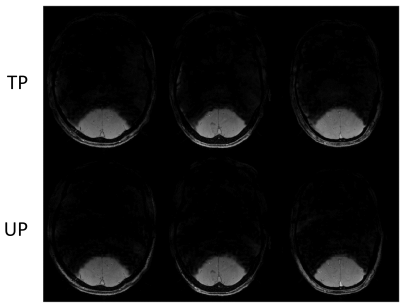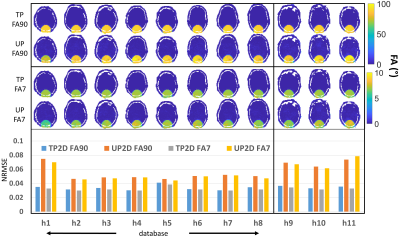Ole Geldschläger1, Dario Bosch1,2, and Anke Henning1,3
1High-field Magnetic Resonance, Max-Planck-Institute for biological Cybernetics, Tübingen, Germany, 2Biomedical Magnetic Resonance, University Hospital Tübingen, Tübingen, Germany, 3Advanced Imaging Research Center, University of Texas Southwestern Medical Center, Dallas, TX, United States
1High-field Magnetic Resonance, Max-Planck-Institute for biological Cybernetics, Tübingen, Germany, 2Biomedical Magnetic Resonance, University Hospital Tübingen, Tübingen, Germany, 3Advanced Imaging Research Center, University of Texas Southwestern Medical Center, Dallas, TX, United States
The ‘Universal pTx Pulse’ concept for local excitation
pulses was applied in vivo at 9.4T. Universal pulses for a 2D local excitation
target pattern were designed. In line with
previous findings for whole-brain excitation pulses they perform just
slightly worse compared to the tailored pulses.

Figure 4: 9.4T T2*-weighted GRE acquisitions (voxel
size: 0.8x0.8x0.8 mm3, matrix size: 224x280, TR = 18 ms, TE = 8ms)
from the three non-database heads. Once, the respective TPs (FA7) were applied,
once the UP (FA7) was applied.

Figure 3: Bloch
simulated FA profiles of the TPs for FA90 (first line of profiles), UP2D for
FA90 (second line), the TPs for FA7 (third line) and UP2D for FA7 (fourth
line). The eight columns on the left present the database heads. The three
columns on the right present the non-database heads. The bar plot below the
profiles illustrates the NRMSEs for each pulse and head.